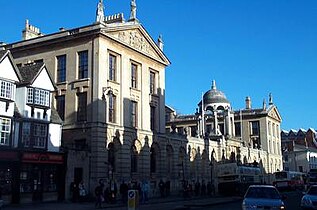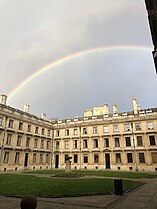The Queen's College, Oxford
| The Queen's College Latin: Collegium Reginae
| |||||||||||||||||
|
Reginae erunt nutrices tuae | |||||||||||||||||
|---|---|---|---|---|---|---|---|---|---|---|---|---|---|---|---|---|---|

| |||||||||||||||||
| Provost: | Claire Craig | ||||||||||||||||
| Website: | queens.ox.ac.uk | ||||||||||||||||
| |||||||||||||||||
| Location | |||||||||||||||||
| Grid reference: | SP51790634 | ||||||||||||||||
| Location: | 51°45’12"N, 1°15’4"W | ||||||||||||||||
The Queen's College is a constituent college of the University of Oxford. The college was founded in 1341 by Robert de Eglesfield in honour of Philippa of Hainault, queen of England.[1] It is distinguished by its predominantly neoclassical architecture, primarily dating from the 18th century.

In 2018, the college had an endowment of £291 million,[2] making it the fourth-wealthiest Oxford college (after Christ Church, St John's, and All Souls).
History

The college was founded in 1341 as "Hall of the Queen's scholars of Oxford" by Robert de Eglesfield (d'Eglesfield), chaplain to the then queen consort Philippa of Hainault, after whom the hall was named.[3] Robert's aim was to provide clergymen for his native Cumberland and where he lived in Westmorland. In addition, the college was to provide charity for the poor. The college's coat of arms is that of the founder; it differs slightly from his family's coat of arms, which did not include the gold star on the breast of the first eagle. The current coat of arms was adopted by d'Eglesfield because he was unable to use his family's arms, being the younger son. D'Eglesfield had grand plans for the college, with a provost, 12 fellows studying theology, up to 13 chaplains, and 72 poor boys. However, the college did not have the funding to support such numbers, and initially had just two fellows.
The college gained land and patronage in the mid-15th century, giving it a good endowment and allowing it to expand to 10 fellows by the end of the century. By 1500, the college had started to take paying undergraduates, typically sons of the gentry and middle class, who paid the fellows for teaching. There were 14 of these in 1535; by 1612, this had risen to 194. The college added lectureships in Greek and philosophy. Provost Henry Robinson obtained an Act of Parliament incorporating the college as "The Queen's College" in 1585, so Robinson is known as the second founder.
Following the new foundation, the college had a good reputation and flourished until the 1750s. Joseph Williamson, who had been admitted as a poor boy and went on to become a fellow, rose to Secretary of State and amassed a fortune. He funded a new range on Queen's Lane built in 1671–72. Following a bequest of books from Thomas Barlow, a new library was built between 1693 and 1696 by master builder John Townesend. A further bequest from Williamson of £6,000, along with purchase of the buildings along the High Street, allowed a new front quad to be built and for the remaining mediæval buildings to be replaced. This was completed by 1759 by John's son William Townesend.[4][5] The college gained a large number of benefactions during this time, which helped to pay for the buildings and bring in more scholars from other, mostly northern, towns.
From the 1750s, as with other Oxford colleges, standards dropped. The Oxford commission of 1850–1859 revised the statutes and removed the northern preference for fellows and most of the students. Over the coming years, requirements for fellows to be unmarried were relaxed, the number of fellows required to have taken orders and studied theology was reduced, and in 1871 the Universities Tests Act allowed non-conformists and Roman Catholics.[6]
Like many of Oxford's colleges, Queen's admitted its first mixed-sex cohort in 1979, after more than six centuries as an institution for men only.[7]
Naming
The college is named for its first patroness, Queen Philippa. Established in January 1341 'under the name of the Hall of the Queen's scholars of Oxford' (sub nomine aule scholarium Regine de Oxon), the college was subsequently called the 'Queen's Hall', 'Queenhall' and 'Queen's College'. The Queen's College, Oxford Act 1584 (27 Eliz. 1. c. 2) sought to end this confusion by providing that it should be called by the one name "the Queen's College";[8] in practice, the definite article is usually omitted. The full name of the College, as indicated in its annual reports, is The Provost and Scholars of The Queen's College in the University of Oxford.
Queens' College in Cambridge positions its apostrophe differently and has no article, as it was named for multiple queens (Margaret of Anjou and Elizabeth Woodville).
Buildings

Front Quad
The main entrance on the High Street leads to the front quad, which was built between 1709 and 1759. There are symmetrical ranges on the east and west sides, while at the back of the quad is a building containing the chapel and the hall.[5] The architect Nicholas Hawksmoor, a leading figure of the Baroque style, provided a number of designs that were not used directly but that heavily influenced the final design. In the cupola above the college entrance is a statue of the British queen Caroline of Ansbach by the sculptor Henry Cheere; the legend 'Carolina Regina, Nov. 12, 1733' may be found marking the laying of the foundation stone of the screen wall, which is visible from the High Street.[5]
Back Quad
A second and older quad lies to the north of the hall and chapel. The west side consists of the library. The east side is the Williamson building, which was originally built to a design by the architect Christopher Wren, known for his work in the Baroque style, but has been largely rebuilt since then.[5]
Chapel

The chapel is noted for its Frobenius organ in the west gallery.[9][10] It was installed in 1965, replacing a Rushworth and Dreaper organ from 1931. The earliest mention of an organ is 1826. The Chapel Choir has been described as "Oxford's finest mixed-voice choir" and continues to perform termly concerts, recent examples of which include Handel's Messiah and Bach's St John Passion.[11][12] The chapel has stood virtually unchanged since it was consecrated by the Archbishop of York in 1719.

Library
The Upper Library
The Upper Library has been a focal point for the College ever since its construction at the end of the 17th century. Unlike many other similar rooms in Oxford libraries, the Upper Library remains as a silent reading room for students open during staffed hours.[13]
Eighteenth Century Globes and Orrery
On display in the middle of the library are two eighteenth century papier maché Senex globes and an orrery from the same period. John Senex was the foremost globe maker of the eighteenth century,[14] and also crafted the miniature globe featured in the orrery. The globes are now found in cases that were designed and fitted by Welsh furniture designer Bernard Allen in 2007, after being removed from the library for a period of time in 2002 for structural repair and restoration by renowned English globe conservator Sylvia Sumira.
The Benjamin Cole orrery was a gift to the College in 1763 from a Group of Gentleman Commoners of the College, recorded in two entries in the Benefactors' Book, as well as on an inscription in the lunar calendar scale.[15] The instrument is made of brass, steel, and wood, contained within a wooden case and resting on a mahogany stand with a glazed cover.[16] Johnathan Betts, in an Excerpt from A report following the servicing and inspection of The Queen's College Grand Orrery in 2016, describes the instrument as standing:
on a fine mahogany table with six finely carved cabriole legs, the whole covered with a multi-panelled protective glass shade which can be locked securely onto the table, preventing access to the orrery.[16]
In the same article, Betts illustrates the orrery:
fitted in a mahogany twelve-sided case, with lacquered brass mounts and surmounted, on a brass pillared gallery, with a large lacquered brass hemispherical armillary structure. The mechanical orrery itself incorporates within its compass the solar system out to Mars, including the Earth and Moon, with additional mountings fixed on the outside of the case for attaching static models of Jupiter and Saturn.[16]
The turning of the orrery is a traditional event at Queen's, done by hand only once every few years or on special occasions. Only two people are permitted to turn the orrery: the Patroness of the College, a position most recently occupied by The Queen Mother, and the Sedleian Professor of Natural Philosophy, a Fellow of Queen's.[17] This event most recently took place on 4 February 2020, during the Hilary term, with professor Jonathan Keating as the honorary orrery-turner.
The Lower and New Libraries
The open cloister below the Upper Library was enclosed in the 19th century to form the Lower Library, which now houses the bulk of the lending collection. The lending collection consists of around 50,000[18] with an additional 70,000 items in the special collections available by appointment.[19] In April 2017 the New Library opened[20] beneath the Provost's Garden,[21] with an official opening by Old Member Rowan Atkinson taking place in November of the same year.[22]
Pictures
-
The Queen's College, view from the High Street
-
View of the Upper Library
-
The Queen's College, Back Quad
-
Back Quad, detail
Outside links
| ("Wikimedia Commons" has material about The Queen's College, Oxford) |
References
- ↑ "History" (in en). https://www.queens.ox.ac.uk/history.
- ↑ "The Queen's College Oxford : Annual Report and Financial Statements : Year ended 31 July 2018". p. 20. http://d307gmaoxpdmsg.cloudfront.net/collegeaccounts1718/The_Queens_College.pdf.
- ↑ "History" (in en). https://www.queens.ox.ac.uk/history.
- ↑ "The Queen's College, Oxford" (in en). https://www.queens.ox.ac.uk/history.
- ↑ 5.0 5.1 5.2 5.3 "Oxford's greatest neo-classical college is restored" (in en-UK). Country Life. 2014-08-17. http://www.countrylife.co.uk/articles/queens-college-oxford-60488.
- ↑ A History of the County of Oxford - Volume 3 pp 132-143: The Queen's College (Victoria County History)
- ↑ "Launch of the Queen's Women's Network". queens.ox.ac.uk. https://www.queens.ox.ac.uk/news/launch-queens-womens-network/.
- ↑ A History of the County of Oxford - Volume 3 p : The University of Oxford (Victoria County History)
- ↑ "The Organ" (in en-GB). https://www.queenschoir.com/the-organ.
- ↑ "The National Pipe Organ Register - NPOR". https://npor.org.uk/NPORView.html?RI=N08080.
- ↑ "The Chapel Choir of The Queen's College Oxford". Guild Records page. http://www.guildmusic.com/artists/choirqco.htm.
- ↑ "Archive". http://www.queenschoir.com/archive/.
- ↑ "Opening Hours - The Queen's College". ox.ac.uk. http://www.queens.ox.ac.uk/library/opening-hours/.
- ↑ "Dorothy Sloan–Rare Books: Auction 22". https://www.dsloan.com/Auctions/A22/item-map-senex-1725.html#:~:text=John%20Senex%20(1678-1740),Society%20on%20July%2024,%201728..
- ↑ Bridgwater, David (2018-12-28). "Bath, Art and Architecture: John Vanderstein at Queen's College,Oxford - Part 12, The Upper Library Doorcase - with some notes concerning the Orrery by Benjamin Cole". http://bathartandarchitecture.blogspot.com/2018/12/john-vanderstein-at-queens.html.
- ↑ 16.0 16.1 16.2 Betts, Jonathan (December 2016). "Excerpt from A report following the servicing and inspection of The Queen's College Grand Orrery, 2016". The Queen's College Library 'Insight' Issue 6, Michaelmas 2016: 15. https://www.queens.ox.ac.uk/sites/www.queens.ox.ac.uk/files/insight-michaelmas-term-2016.pdf. Retrieved 22 September 2020.
- ↑ Shaw, Tessa (September 2011). "The orrery in the Upper Library". The Queen's College Library 'Insight' Issue 1, Michaelmas 2011: 15. https://www.queens.ox.ac.uk/sites/www.queens.ox.ac.uk/files/Insight2011.pdf. Retrieved 22 September 2020.
- ↑ "The Queen's College, Oxford" (in en). https://www.queens.ox.ac.uk/current-students.
- ↑ "The Queen's College, Oxford" (in en). https://www.queens.ox.ac.uk/researchers.
- ↑ "The Queen's College, Oxford" (in en). https://www.queens.ox.ac.uk/news/new-library-opens-students.
- ↑ "The Queen's College, Oxford" (in en). https://www.queens.ox.ac.uk/new-library.
- ↑ "The right thing at the right time" (in en). https://www.queens.ox.ac.uk/news/right-thing-right-time.
| Colleges of the University of Oxford | |
|---|---|
| Colleges:
All Souls • Balliol • Brasenose • Christ Church • Corpus Christi • Exeter • Green Templeton • Harris Manchester • Hertford • Jesus • Keble • Kellogg • Lady Margaret Hall • Linacre • Lincoln • Magdalen • Mansfield • Merton • New College • Nuffield • Oriel • Pembroke • The Queen's • Reuben • St Anne's • St Antony's • St Catherine's • St Cross • St Edmund Hall • St Hilda's • St Hugh's • St John's • St Peter's • Somerville • Trinity • University • Wadham • Wolfson • Worcester |
|
| Permanent private halls:
Blackfriars • Campion Hall • Regent's Park College • St Benet's Hall • St Stephen's House • Wycliffe Hall | |



